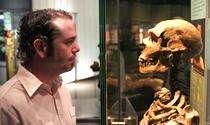Probing Question: What can we learn from Neanderthal DNA?

Contrary to their image as knuckle-dragging brutes, the Neanderthals on television play tennis and attend cocktail parties — and sell auto insurance. In reality, these mysterious fellow hominids died out about 30,000 years ago. Today, an international research team is extracting DNA from Neanderthals who were, literally, cavemen. (Their bones were found in Croatian caves.)
What can we learn from the DNA of extinct humans?
"It can tell us a story about human history," says Webb Miller, Penn State professor of biology and computer science. Miller has been a leader in several major genome sequencing projects, which decipher the genetic code of all the chromosomes of an individual. Comparing the DNA sequences of modern and ancient humans can show us similarities and differences in our basic biology, he notes. It can tell us which prehistoric populations died out completely, and which contributed genes to modern humans. It can even be used to reconstruct the appearance of ancient humans. In 2007, scientists working on a single gene found that some Neanderthals may have had light skin and red hair.
As Miller explains, tens of thousands of years ago modern humans may have co-existed with Neanderthals, who were not Homo sapiens like us, but a different species, Homo neanderthalensis. Despite their differences, some say it's likely that a few prehistoric one-night stands occurred during that time. The question is whether they left a lasting impression in the form of genes shared between Neanderthals and modern humans for things like speech, language, and brain development.
Genetic information can also tell us about the travel patterns of ancient humans, says Miller. "The genome sequence of a man who lived in Greenland 4,000 years ago was published recently, and that information is being used to trace the movement of human populations." His genome tells us that this individual was part of a wave of people who invaded Greenland from Northeastern Siberia, about 5,000 years ago, Miller says, when it was already populated with people who had arrived over 5,000 years earlier. The data also show that he resembled modern-day Asians, with brown eyes, and dark skin and hair. He may also have been going bald.
Getting DNA from ancient humans isn't typically an easy task, Miller says, but the scientists who sequenced the Greenland sample were lucky: they were able to take the DNA from a tuft of hair, which Miller and colleagues have shown to be a particularly good source material. The hair was found in permafrost, which also helped preserve the DNA.
The question almost everybody asks about genome mapping, says Miller, is "Can we bring them back? Can we clone these ancient prehumans or extinct animals?" That's definitely not the point of his research. Rather, he says, sequencing genomes from extinct and living individuals can illuminate the diversity in a species and its ancestors. For humans, this information can be valuable for understanding variations in disease susceptibility and response to treatment. For animals, sequence information is used to maintain diversity, for example in captive breeding programs for endangered species. Rather than bringing back humans or animals from extinction, Miller quips, "I'm just trying to keep the ones we've got."
He has communicated with the scientists on the Neanderthal genome project, and says they are preparing to publish their results. That means we might know soon if we have anything in common with the guys in the commercials, besides a need for cheap car insurance.
Provided by Pennsylvania State University



















